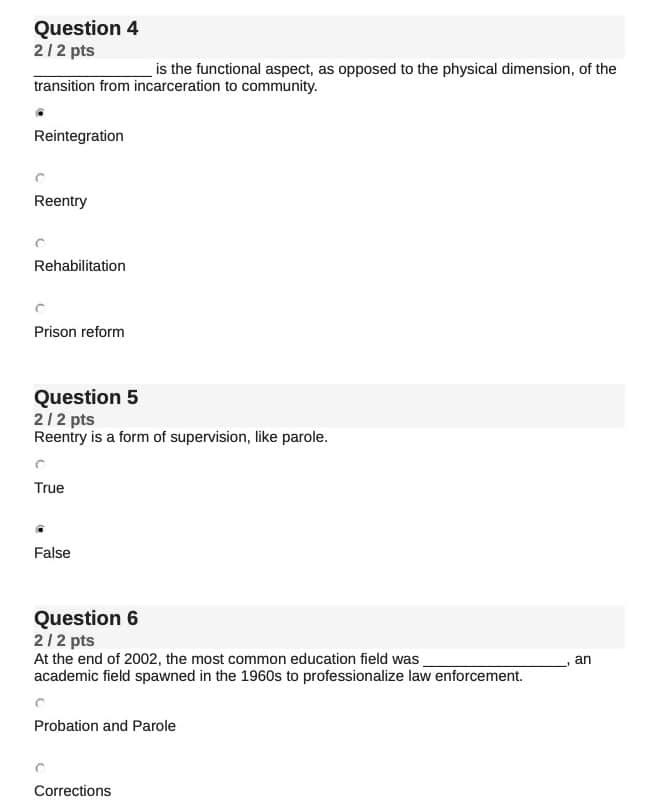CJUS 650 Quiz 8
CJUS 650 Quiz 8 Liberty University
- Examining public attitudes is also the same token that politicians and policymakers use to pass new legislation and to tally electoral votes.
- Reintegration comprises the availability and use of ________________ services and the psychosocial adaptation of the ex-offender.
- Reentry refers to intervention strategies or programs.
- is the functional aspect, as opposed to the physical dimension, of the transition from incarceration to community.
- Reentry is a form of supervision, like parole.
- At the end of 2002, the most common education field was _________________, an academic field spawned in the 1960s to professionalize law enforcement.
- More than __________ of our prison and jail inmates are diagnosed with some mental health problem.
- Evidence-based rehabilitation does not address the root causes of crime.
- is the actual intervention and treatment, guided by a thorough assessment of risks and needs, administered during incarceration.
- is the continuation of the rehabilitation process and underpins the reentry process.
- is the physical resettlement and participation in the community of a former inmate.
- Approximately 700,000 people will leave state and federal prisons this year.
- provide the critical link between the prison-based rehabilitation process and the transition from incarceration to community.
- Why does the Second Chance Act promote research initiatives?
- What is the Triple R Model and how does the process begin?
Other sets
- Why does the Second Chance Act promote research initiatives?
- Reentry is a form of supervision, like parole.
- More than __________ of our prison and jail inmates are diagnosed with some mental health problem.
- Evidence-based rehabilitation does not address the root causes of crime.
- provide the critical link between the prison-based rehabilitation process and the transition from incarceration to community.
- Reentry refers to intervention strategies or programs.
- At the end of 2002, the most common education field was _________________, an academic field spawned in the 1960s to professionalize law enforcement.
- is the actual intervention and treatment, guided by a thorough assessment of risks and needs, administered during incarceration.
- Reintegration comprises the availability and use of ________________ services and the psychosocial adaptation of the ex-offender.
- is the functional aspect, as opposed to the physical dimension, of the transition from incarceration to community.
- What is the Triple R Model and how does the process begin?
- Examining public attitudes is also the same token that politicians and policymakers use to pass new legislation and to tally electoral votes.
- is the continuation of the rehabilitation process and underpins the reentry process.
- is the physical resettlement and participation in the community of a former inmate.
- Approximately 700,000 people will leave state and federal prisons this year.
Other sets
Set 1
- Reentry is a form of supervision, like parole.
- Reentry refers to intervention strategies or programs.
- Examining public attitudes is also the same token that politicians and policymakers use to pass new legislation and to tally electoral votes.
- Approximately 700,000 people will leave state and federal prisons this year.
- Reintegration comprises the availability and use of ________________ services and the psychosocial adaptation of the ex-offender.
- What is the Triple R Model and how does the process begin?
- More than __________ of our prison and jail inmates are diagnosed with some mental health problem.
- _______________ is the physical resettlement and participation in the community of a former inmate.
- At the end of 2002, the most common education field was _________________, an academic field spawned in the 1960s to professionalize law enforcement.
- Why does the Second Chance Act promote research initiatives?
- _ is the actual intervention and treatment, guided by a thorough assessment of risks and needs, administered during incarceration.
- _____________ is the functional aspect, as opposed to the physical dimension, of the transition from incarceration to community.
- Evidence-based rehabilitation does not address the root causes of crime.
- provide the critical link between the prison-based rehabilitation process and the transition from incarceration to community.
- _______________ is the continuation of the rehabilitation process and underpins the reentry process.
Set 2
- __________________ provide the critical link between the prison-based rehabilitation process and the transition from incarceration to community.
- Why does the Second Chance Act promote research initiatives?
- Reintegration comprises the availability and use of ________________ services and the psychosocial adaptation of the ex-offender.
- Reentry refers to intervention strategies or programs.
- Approximately 700,000 people will leave state and federal prisons this year.
- _______________ is the actual intervention and treatment, guided by a thorough assessment of risks and needs, administered during incarceration.
- Examining public attitudes is also the same token that politicians and policymakers use to pass new legislation and to tally electoral votes.
- What is the Triple R Model and how does the process begin?
- Evidence-based rehabilitation does not address the root causes of crime.
- Reentry is a form of supervision, like parole.
- _______________ is the physical resettlement and participation in the community of a former inmate.
- _______________ is the continuation of the rehabilitation process and underpins the reentry process.
- More than __________ of our prison and jail inmates are diagnosed with some mental health problem.
- At the end of 2002, the most common education field was _________________, an academic field spawned in the 1960s to professionalize law enforcement.
- ______________ is the functional aspect, as opposed to the physical dimension, of the transition from incarceration to community.
